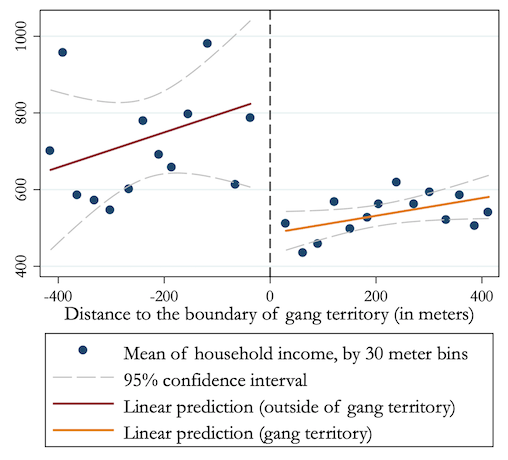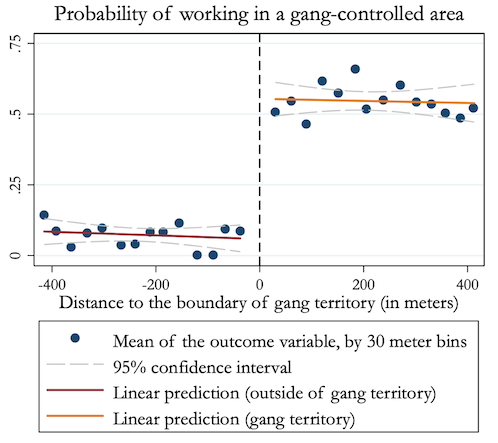
For individuals living in El Salvador’s gang territories, restrictions on freedom of movement significantly limit one’s labour market options
How do non-state armed actors, such as criminal organisations, affect economic growth? In developed societies, the effect is likely to be negative as they might impede the government from providing public goods, enforcing property rights and contracts, and preventing violence (Acemoglu et al. 2001, Michalopoulos and Papaioannou 2013). However, if the government is weak and unable to control parts of its territory, non-state armed actors may fulfil essential institutional functions, potentially enabling economic growth (Arjona et al. 2019, Bates et al.2002, De la Sierra 2020, Olson 1993, Tilly 1985).
In a recent paper (Melnikov et al. 2020), we analyse the effect of a particular type of non-state armed actor – namely, criminal organisations – on socioeconomic development in El Salvador. During the past two decades, large parts of the country have been controlled by two of the world’s most powerful gangs: MS-13 (Mara Salvatrucha) and 18th Street (Barrio 18).
A pivotal moment: Shifting immigration policies
Our analysis takes advantage of the fact that the emergence of organised crime in El Salvador was largely the result of a shift in American immigration policy.
Prior to the late 1990s, El Salvador did not have any major gangs. However, in 1997, a new US immigration policy resulted in the deportation of many individuals with criminal backgrounds back to El Salvador. These individuals, including many known gang members, quickly established MS-13 and 18th Street and gained control over certain parts of the country.1
Due to this fact, we are able to not only estimate the current differences in socioeconomic development between the gang and non-gang neighbourhoods but also verify that these differences did not exist before the arrival of the gangs.
The evidence: After gang control
Using data from the 2007 census and from the geocoded survey we conducted in 2019, we show that, in recent years, residents of gang-controlled neighbourhoods in El Salvador have worse dwelling conditions, less income, and a lower probability of owning durable goods compared to individuals living just 50 meters away but outside of gang territory. They are also less likely to work in large firms.
The magnitudes of this effect are very large. For instance, as seen in Figure 1, residents of gang areas have US$350 lower income compared to individuals living in neighbouring non-gang locations. Given that the average income in the sample is $625, this discontinuity implies a reduction in income of more than 50%.
Figure 1 Household income inside and outside of gang territory

The evidence: Before the gangs
We replicate the analysis with data from the 1992 census. Before the arrival of gangs, neighbourhoods on either side of the boundary of gang territory had similar socioeconomic and geographic characteristics. Moreover, we expand this analysis using satellite data on nighttime light density, which recent studies have found to be a good proxy for local development (Chen and Nordhaus 2011, Henderson et al. 2012). Starting from 1997, the year when the gang members were deported from the US to El Salvador, areas with gang presence experienced lower growth in light density compared to areas without gang presence. Before 1997, both types of locations experienced the same rates of growth in nighttime light density.
The key mechanism: Restrictions on mobility
A key mechanism through which gangs affect socioeconomic development in the neighbourhoods they control is by restricting individuals’ mobility. In order to maintain control over their territory and prevent the police and members of rival gangs from entering, both MS-13 and 18th Street have instituted a system of checkpoints. They do not allow individuals to freely enter or leave their neighbourhoods (e.g. International Crisis Group 2018).
For instance, Figure 2 shows that residents of gang territory are 50 percentage points more likely to work inside of gang territory.
Figure 2 Probability of working in a gang-controlled area

Residents of gang areas are also aware of the restrictions on their mobility. They are less likely than those living in non-gang locations to say that there is freedom of movement in their neighbourhood. Importantly, while individuals who both live and work in gang-controlled areas have significantly worse labour market outcomes than individuals from outside of gang territory, this gap is up to 85% smaller for residents of gang locations who work in non-gang areas.
Conclusion: A significant negative effect on socioeconomic development
We found no evidence for other potential determinants of lower socioeconomic development in gang-controlled neighbourhoods including: selective migration of individuals across the boundary of gang territory, differential exposure to violence, or higher levels of unemployment and informal employment in gang-controlled neighbourhoods. 
In particular, we find no differences in the availability and quality of public goods provision (i.e. schools, hospitals, etc.). This result is consistent with the qualitative evidence, which suggests that the government has been willing to provide public goods in gang-controlled areas in order to not ostracise the residents of those locations and gangs have been willing to let the state enter since they also benefit from public goods in their neighbourhoods.
Overall, our findings suggest that, in developing countries, organised crime can have a significant negative effect on socioeconomic development. We also document that restrictions on individuals’ mobility are an important mechanism behind these effects. Notably, although our analysis focuses on El Salvador, similar mobility restrictions exist in Brazil, Colombia, Honduras, Guatemala, Mexico, and other countries where gangs, cartels, or other non-state armed actors control parts of the country. Thus, these insights are likely to apply to many other countries as well.
References
Acemoglu, D, S Johnson and J Robinson, (2001), “The Colonial Origins of Comparative Development: An Empirical Investigation”, American Economic Review 91(5): 1369–1401.
Arjona, A, J Arteaga, C Cardenas, A Ibanez and P Justino, (2019), “The Effects of Wartime Institutions on Households’ Ability to Cope with Shocks: Evidence for Colombia.” WIDER Working Paper No. 2019/84.
Bates, R, A Greif, and S Singh, (2002), “Organizing violence”, Journal of Conflict Resolution 46(5): 599– 628.
Chen, X and W Nordhaus, (2011) “Using luminosity data as a proxy for economic statistics”, PNAS 108(21): 8589–8594.
De la Sierra, R,, (2020) “On the Origins of the State: Stationary Bandits and Taxation in Eastern Congo”, Journal of Political Economy 128(1).
Henderson, J. Vernon, A Storeygard and D N. Weil, (2012), “Measuring Economic Growth from Outer Space”, American Economic Review 102(2): 994–1028.
International Crisis Group, (2018), “Life Under Gang Rule in El Salvador”, Latin America & Caribbean Commentary.
Melnikov, N, C Schmidt-Padilla and M Micaela Sviatschi, (2020), “Gangs, Labor Mobility, and Development”, NBER Working Paper w27832.
Michalopoulos, S, and E Papaioannou, (2013), “Pre-Colonial Ethnic Institutions and Contemporary African Development”, Econometrica 81(1): 113–152.
Olson, M, (1993), “Dictatorship, Democracy, and Development”, American Political Science Review 87(3): 567–576.
Tilly, C, (1985), “War-making and State-making as Organized crime,” in Collective Violence, Contentious Politics, and Social Change, Routledge, pp. 21–139.
Endnotes
1 After the gangs gained control over certain parts of the country in the late 1990s, the government of El Salvador has managed to prevent the gangs from expanding further. However, the government has not been able to regain control over the territories controlled by the gangs. Thus, from the early 2000s onwards, the boundaries of gang territory have been relatively stable.


